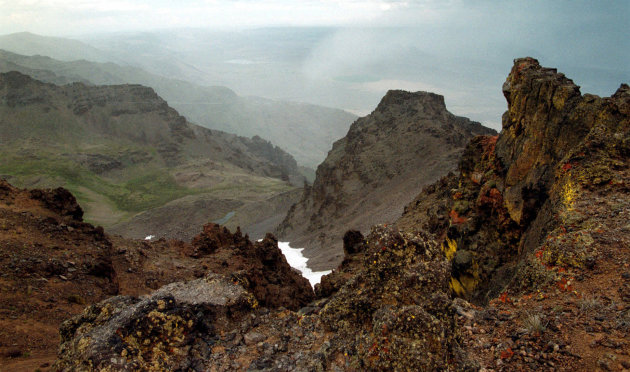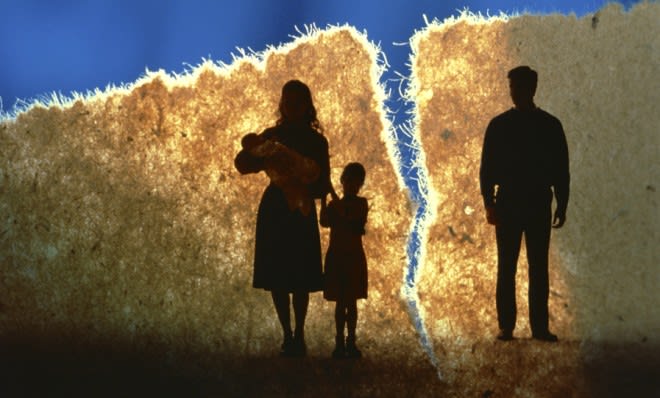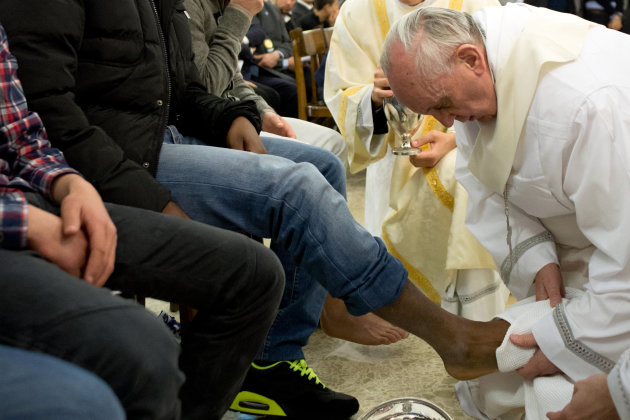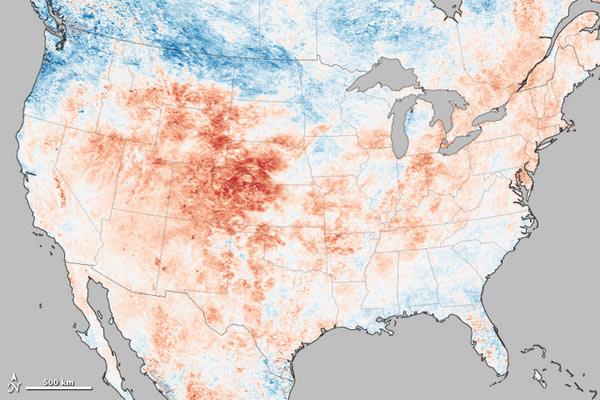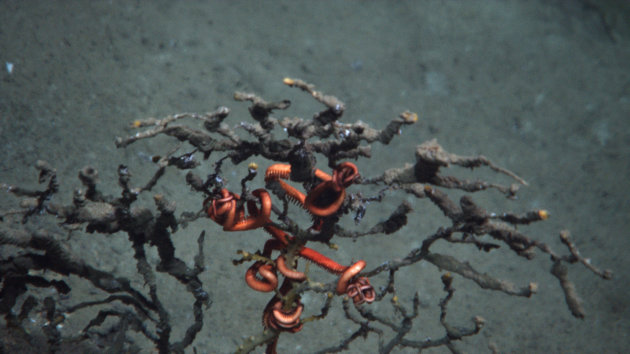Parents deported, what happens to US-born kids? — Alexis Molina was just 10 years old when his mother was abruptly cut out of his life and his carefree childhood unraveled overnight.
Gone were the egg-and-sausage tortillas that greeted him when he came home from school, the walks in the park, the hugs at night when she tucked him into bed. Today the sweet-faced boy of 11 spends his time worrying about why his father cries so much, and why his mom can't come home.
"She went for her papers," he says. "And she never came back."


Janna Hakim, 18, shows a poster featuring a picture of her mother Faten on Thursday, Aug. 16, 2012 in New York. On Aug. 13, 2010, Faten was taken away from home by ICE officials and deported to Ramallah, Palestine. Janna has since engaged in public efforts to reunite the family. (AP Photo/Bebeto Matthews)
Alexis' father, Rony Molina, who runs a small landscaping company, was born in Guatemala but has lived here for 12 years and is an American citizen. Alexis and his 8-year-old brother, Steve, are Americans, too. So is their 19-year-old stepsister, Evelin. But their mother, Sandra, who lived here illegally, was deported to Guatemala a year and a half ago.
"How can my country not allow a mother to be with her children, especially when they are so young and they need her," Rony Molina asks, "and especially when they are Americans?"
It's a question thousands of other families are wrestling with as a record number of deportations means record numbers of American children being left without a parent. And it comes despite President Barack Obama's promise that his administration would focus on removing only criminals, not breaking up families even if a parent is here illegally.
Nearly 45,000 such parents were removed in the first six months of this year, according to Immigration and Customs Enforcement (ICE).
Behind the statistics are the stories: a crying baby taken from her mother's arms and handed to social workers as the mother is handcuffed and taken away, her parental rights terminated by a U.S. judge; teenage children watching as parents are dragged from the family home; immigrant parents disappearing into a maze-like detention system where they are routinely locked up hundreds of miles from their homes, separated from their families for months and denied contact with the welfare agencies deciding their children's' fate.
At least 5,100 U.S. citizen children in 22 states live in foster care, according to an estimate by the Applied Research Center, a New York-based advocacy organization, which first reported on such cases last year.
And an unknown number of those children are being put up for adoption against the wishes of their parents, who, once deported, are often helpless to fight when a U.S. judge decides that their children are better off here.
Immigration lawyers say that — despite the ICE policy changes — they see families destroyed every day.
"I had no idea what was happening," says Janna Hakim of the morning in 2010 when a loud knocking at her Brooklyn apartment door jolted her awake. It was the first Friday of Ramadan, and her Palestinian mother, Faten, was in the kitchen baking the pastries she sold to local stores.
Janna, then 16, and her siblings were all born here. None knew that their mother was in the U.S. illegally — or that a deportation order from years earlier meant she could be whisked away by ICE agents and her family's comfortable New York life could come crashing to a halt.
"It was horrible, horrible," Janna says, describing the shock of seeing her mother in an ill-fitting prison uniform behind a grimy glass panel in a detention center in Elizabeth, N.J. She was deported after three months. Her family fell apart.
Janna's 13-year-old brother began wetting his bed, she said, and her 15-year-old brother began hanging out with gangs and experimenting with drugs. Her father, who has a prosthetic leg and relied on his wife for help, grew despondent. And her mother, back in Ramallah living with her own mother after more than 20 years away, grew desperate, unable to sleep or function or think about anything except her family.
"I am not a criminal. I am the mother of American children and they need me, especially the younger ones," she cried over the phone. "How can a country break up families like this?"
Critics say the parents are to blame for entering the country illegally in the first place, knowing they were putting their families at risk.
"Yes, these are sad stories," says Bob Dane, spokesman for the Federation for American Immigration Reform, which advocates tougher enforcement against illegal immigration. "But these parents have taken a reckless gamble with their children's future by sneaking into the country illegally, knowing they could be deported."
"Not to deport them," he continued, "gives them the ultimate bonus package, and creates an incentive for others to do the same thing."
Others, including Obama, say splitting up families is wrong.
"When nursing mothers are torn from their babies, when children come home from school to find their parents missing ... when all this is happening, the system just isn't working and we need to change it," Obama declared during his first run for president in 2008. A year ago, he told a Texas audience that deportation should target "violent offenders and people convicted of crimes; not families, not folks who are just looking to scrape together an income."
And, last year ICE announced a new policy of "prosecutorial discretion" that directs agents to consider how long someone has been in the country, their ties to communities and whether that person's spouse or children are U.S. citizens.
"That gave us a lot of hope," said David Leopold, general counsel for The American Immigration Lawyers Association. "Now we are all scratching our heads wondering where is the discretion when many of our lawyers continue to see people being deported with no criminal record, including parents of American children."
___
In the Molina case in Connecticut, after Rony Molina became a U.S. citizen in 2009, an immigration attorney urged Sandra to go to Guatemala, where her husband could then sponsor her to return legally.
It was bad advice. Though she has no criminal record her petition was denied. Desperate, she tried to re-enter with the aid of a "coyote" who demanded $5,000, but she was stopped at the border, detained in Arizona for two weeks, then deported in March 2011.
Immigrants who are deported and try to re-enter the country are considered felons and a top priority for immediate removal.
Back in Guatemala, she faced what many deportees experience — loneliness, suspicion and fear in a country that no longer felt familiar. She says her brother was held for ransom by kidnappers who presumed her American husband must be wealthy enough to pay. Eventually she fled to Mexico, where she says she feels so hopeless about her life that she has thought about ending it.
"I just want to be forgiven," she said, sobbing on the phone. "I feel I am about to go crazy, I miss my children so much. They are all I have. I cannot go on without them."
Back home in Stamford, her children are suffering too. The youngest cried constantly, the eldest became angry and withdrawn. Though their plight is documented in thick files that include testimony from psychologists and counselors about their need for their mother, appeals for humanitarian relief were denied.
"Quiet, slow-motion tragedies unfold every day ... as parents caught up in immigration enforcement are separated from their young children and disappear," Nina Rabin, an associate clinical professor of law at the University of Arizona, wrote last year in "Disappearing Parents: A Report on Immigration Enforcement and the Child Welfare System."
Rabin, an immigration lawyer, says one of the most unsettling experiences of her life was witnessing the "cruel and nightmarish destruction" of one Mexican family whom she represented in a fruitless attempt to keep a mother and her children together.
The mother, Amelia Reyes-Jimenez, carried her blind and paralyzed baby boy, Cesar, across the Mexican border in 1995 seeking better medical care, Rabin said. She settled in Phoenix — illegally — and had three more children, all American citizens. In 2008 she was arrested after her disabled teen son was found home alone.
"When they took my girls, I felt as if my heart fell out," she said during an immigration court hearing. She described how her 3-month-old daughter, Erica, was snatched from her arms as the other children, ages 7, 9 and 14, screamed, "Mommy, Mommy."
Locked in detention, clueless as to her rights or what was happening to her children, she pleaded guilty to child endangerment charges, and then spent two years fighting to stay with her children.
Twice her attorneys tried to convince an immigration judge that she qualified for a visa "on account of the harm that would be done to her three U.S. citizen children if she were to be deported," Rabin said. She lost and was deported back to Mexico in 2010.
Last year, her parental rights were terminated by an Arizona court after a judge ruled that she had failed to make progress towards reunification with her children — something Rabin said was impossible to do, locked away for months without access to legal counsel or notifications from the child welfare agency.
The children are in foster homes and will likely be placed for adoption. Reyes-Jimenez works for a factory making cell phones, crying constantly over the loss of her family.
Her case is before the Arizona State Court of Appeals, but Rabin says regardless of the outcome the family has been destroyed.
"Amelia's case is not a fluke," Rabin says. "Tragically, we hear of cases like this every day."
A key reason, she says, is the extreme disconnect between federal immigration and state child welfare policies that leads to "Kafkaesqe results" when parents and children are swallowed up by the system.
Many advocacy agencies now encourage immigrants to have a detailed plan in place in case they are deported, including granting power of attorney in advance to someone who can take custody of their children.
ICE, meanwhile, maintains it tries to work with such groups to ensure "family unity."
"ICE takes great care to evaluate cases that warrant humanitarian release," said spokeswoman Dani Bennett. "For parents who are ordered removed, it is their decision whether or not to relocate their children with them."
But immigration lawyers say that is not so easy. A recurring complaint is that clients "disappear," often sent to detention centers far from where they lived. They are routinely denied access to family court hearings, phones and attorneys. Many immigrant parents do not fully understand their rights, or that custody of their children might be slipping away.
Federal law requires states to pursue "termination of parental rights" if the parent has been absent for 15 out of 22 consecutive months, and some states allow proceedings to begin even sooner. In some cases, foreign consulates have intervened directly in a deportee's fight to retain parental rights.
In 2007, Encarnacion Bail Romero lost custody of her 6-month-old son, Carlos, after she was arrested during an ICE raid on a chicken plant in Missouri. While she was imprisoned, her baby was first cared for by relatives and later adopted, against her wishes, by a Missouri couple after a judge said the child was better off with them.
"Smuggling herself into a country illegally and committing crimes in this country is not a lifestyle that can provide any stability for a child," wrote circuit court Judge David Dally.
Last year the Missouri Supreme Court called the decision "a travesty of justice," saying "investigation and reporting requirements" weren't met before the mother's rights were terminated, and it sent the case back for retrial.
Although Bail Romero was ordered deported, the Guatemalan government arranged for her to get temporary legal status so that she could stay in the U.S. to fight in court for Carlos — now 5 and renamed Jamison by his adoptive parents. She hoped to bring the boy back to Guatemala to raise him with her two other children.
"I am the mother of Carlitos," she said, begging the court to return her child.
Her pleas were ignored. In July, a Greene County judge terminated her parental rights, saying she had effectively abandoned her son.
___
In the little mountain town of Sparta, N.C., the family of Felipe Montes is facing a similar fight. When immigration agents deported the 32-year-old laborer to Mexico two years ago, his three young sons — American citizens — were left in the care of their mentally ill, American-born mother. Within two weeks, social workers placed the boys in foster care.
Montes and his wife want the children to live with him in Mexico, saying they are better off with their father than with strangers in the U.S. He works at a walnut farm and shares a house with his uncle, aunt and three nieces.
But child welfare officials have asked a judge to strip Montes of his parental rights, arguing the children will have a better life here. Such a ruling could clear the way for their adoption.
"I don't drink, I don't smoke, I don't use drugs," Montes said earlier this year. "I have always taken care of my children, I have always loved them."
But parental love is only part of the equation. Even when children join their deported parents in order to keep the family together, it can be a struggle to adjust. In many cases they don't speak the language and fall behind at school. Often standards of living are much poorer than what they were accustomed to.
"They don't have the same access to health care or education," says Aryah Somers, a Washington-based immigration lawyer who is in Guatemala on a Fulbright scholarship studying the effects of U.S. immigration policies on children. "Their parents can't even afford to buy the food that they are accustomed to, so we see a lot of children who are U.S. citizens suffering from malnutrition and living in conditions that would not be acceptable back home."
Sixteen of these American children live in the small Guatemalan mountain town of San Jose Calderas, growing up in extreme poverty, with little schooling and scant medical care. Their parents were among the nearly 400 immigrants rounded up in an ICE raid on a meatpacking plant in Iowa in 2008. The kids are undernourished and barely literate in either Spanish or English, Somers says.
But they have something their Guatemalan cousins can only dream of — a U.S. passport, their ticket to a better life. As soon as they are old enough — 10 or 12 — some parents say they will put them on a plane back to the U.S. And then, Somers says, the country will have to deal with — and pay for — the social, medical and psychological repercussions of banishing them in the first place.
Somers, who has been in Guatemala for eight months, says she has encountered scores of deportees who were removed from their families, including many who have no criminal record and were deported after the new ICE discretionary policy was announced.
She described a mother from Los Angeles, a victim of domestic violence, who was deported earlier this year after police responded to a fight at her home. Desperate to return to her 3-year-old son, a citizen, the woman recently went to Mexico, where she plans to try to cross the border again, illegally.
Although Somers advised against that, she understands. "How can you blame her?" Somers asks. "Her frustration and devastation was just so complete."
There are some signs of change. Somers said she has heard about ICE agents boarding a deportation jet before it left the U.S. and freeing deportees who had lived in the country since they were children and gone to school here — a direct response to Obama's June executive order allowing such young people with no criminal record to temporarily stay and work.
Homeland Security Secretary Janet Napolitano said at the time that the policy change is part of a general shift by the administration to focus on deporting high-priority illegal immigrants.
In Chicago, Marilu Gonzalez, a coordinator at the Roman Catholic archdiocese's office of immigrant affairs, recently saw her first example of that shift. An immigrant mother, living here illegally, was arrested for driving under the influence and sent to a detention center. However, instead of being deported, she was released with an ankle monitoring bracelet and given a stay. And, instead of being placed in foster care, her children were permitted to stay with her sister, who is also here illegally.
"That would not have happened in the past," said Gonzalez, who sees hundreds of such cases. "She would have been deported."
In another rare move, Felipe Montes, the father who wants his children from North Carolina to join him in Mexico, has been granted permission to temporarily return to the U.S. to attend custody hearings, though he must wear an ankle monitoring bracelet.
Still, Gonzalez and others say the changes are too haphazard and random, open to interpretation by individual ICE agents. And many say it seems particularly cruel that deported parents who return illegally in order to be with their children should be a priority for removal.
In Congress, California Rep. Lucille Roybal-Allard has proposed legislation that would make it more difficult for local agencies to terminate the parental rights of immigrants. She calls it "heartbreaking ... that in the U.S., immigration status in itself has become grounds to permanently separate families." It is, she said, "absolutely, unquestionably inhumane and unacceptable, particularly for a country that values family and fairness so highly."
Twenty-four-year-old Lucas Da Silva knows all too well the heartbreak of having a parent deported. He vividly describes the day in 2009 that his father, didn't return home from his job cleaning swimming pools in Orlando, Fla.
"Until then, we were just a normal American family," Da Silva said. "Now, I don't know if we ever can be a proper family again."
With his father back in Brazil, Lucas, struggled to become the head of the house, even as he felt powerless listening to his 14-year-old year sister cry every night, seeing his mother straining to make ends meet, and watching his parents' marriage deteriorate.
"Everyone seems to agree that the current system is broken," he says. "But people don't seem to understand that it breaks families too." ( The Associated Press )
Eds: Helen O'Neill is a national writer for The Associated Press, based in New York. She can be reached at features(at)ap.org.
READ MORE - Parents deported, what happens to US-born kids?
